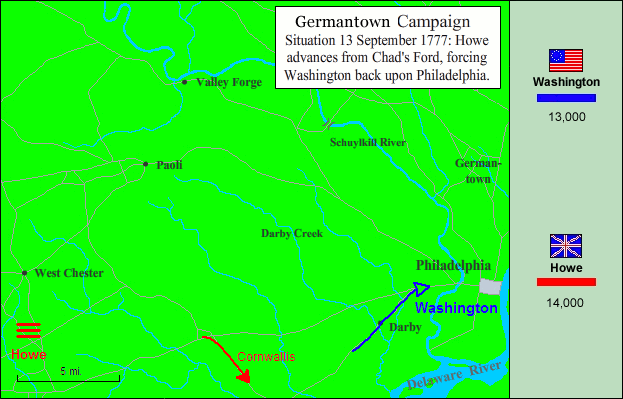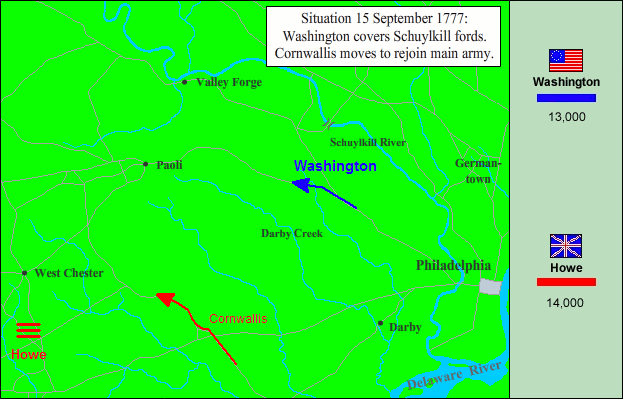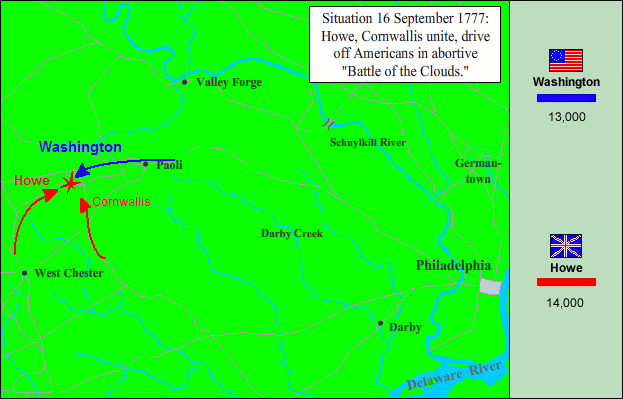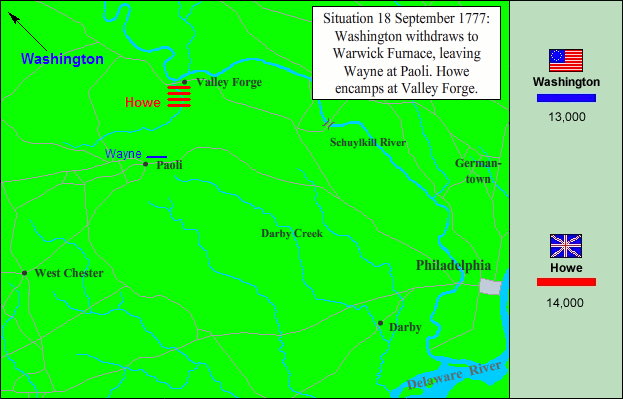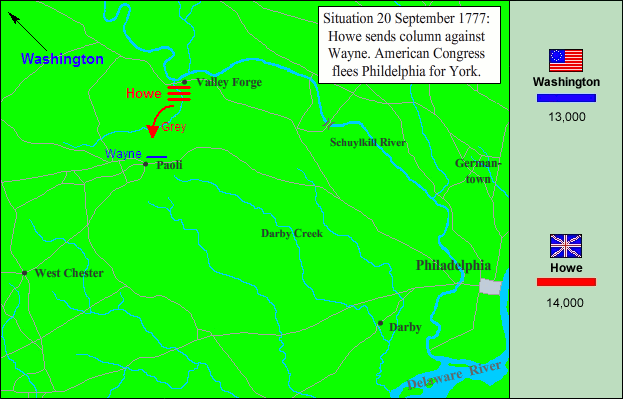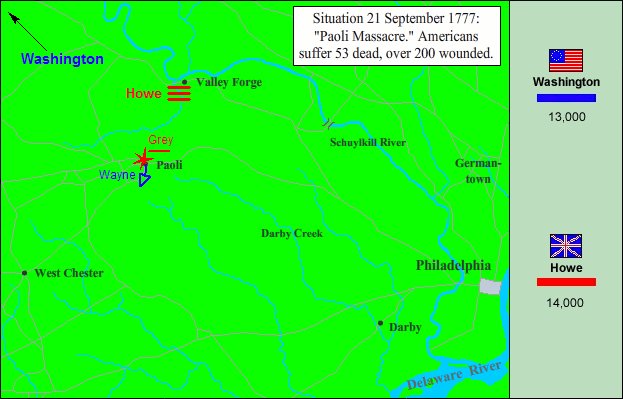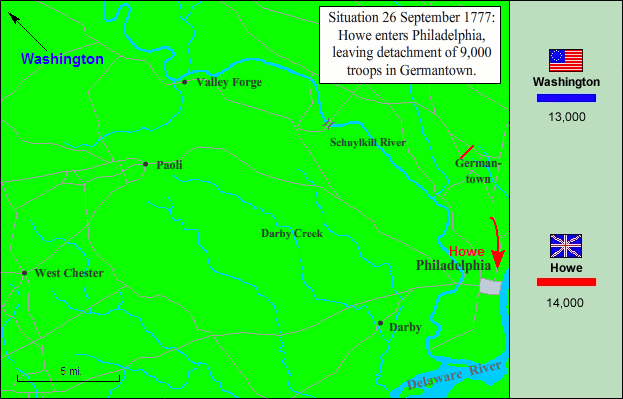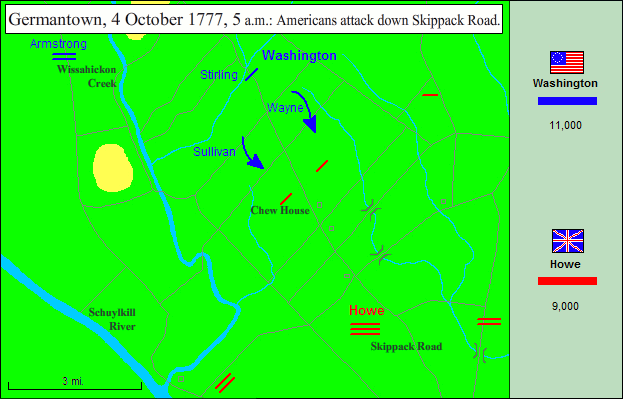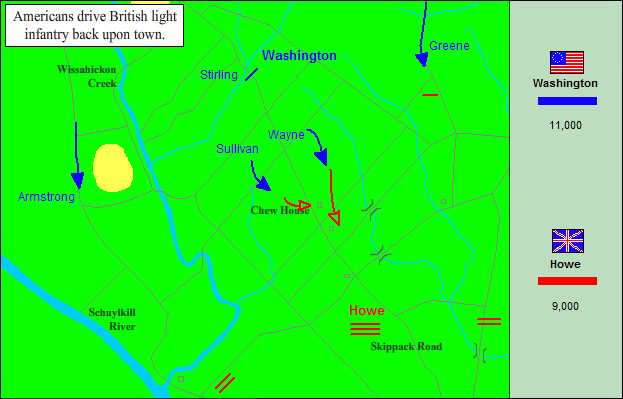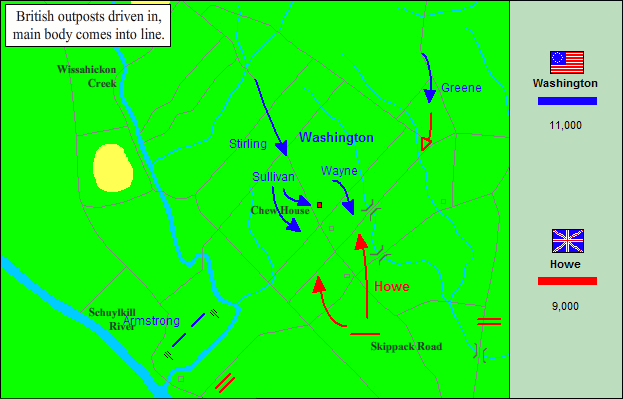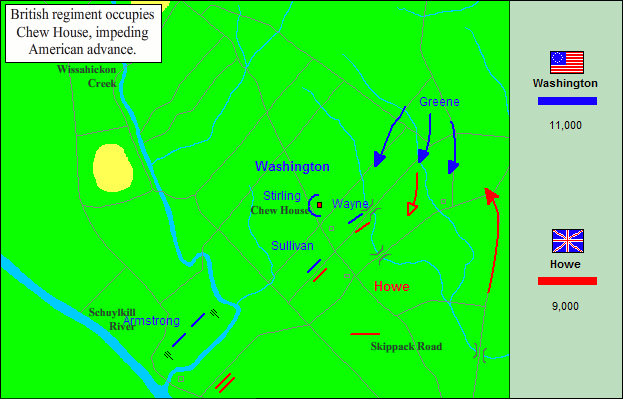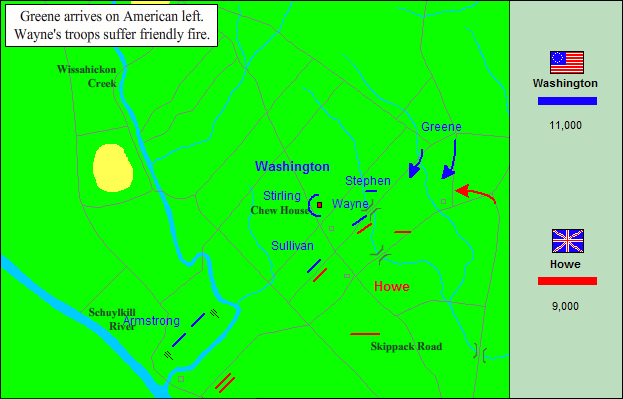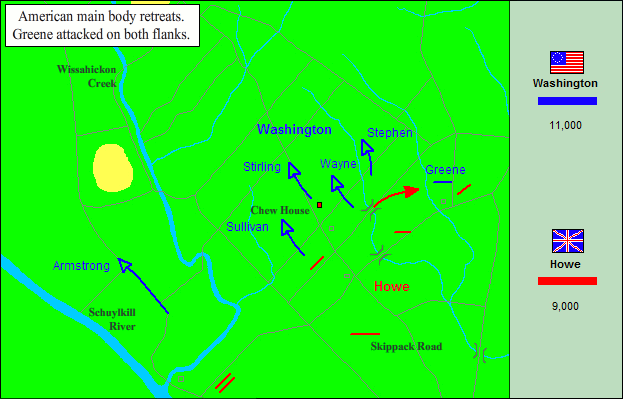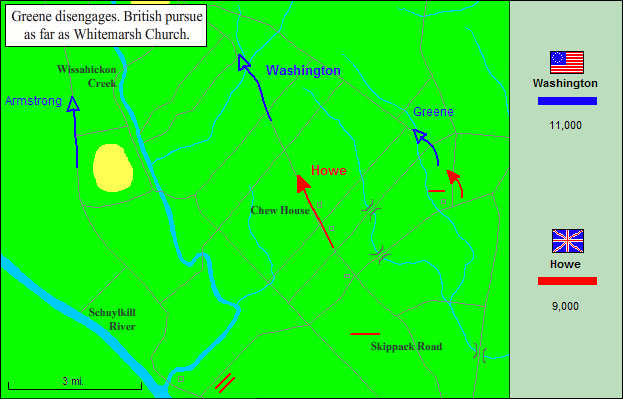Germantown
Fortune smiled on us for full three hours. The enemy were broke, dispersed and flying in all quarters….
–General Anthony Wayne
Falling back on the capital in the wake of the defeat at Brandywine Creek, Washington acted quickly to make good his considerable losses, ordering 2,500 Continentals down from Peekskill on the Hudson and appealing to the Patriot countryside for more militia. In the next two weeks nearly a thousand of the Line and more than two thousand militiamen from New Jersey and Maryland reached him. There was a good deal more marching and sparring than hard fighting now as Washington looked for an opportunity to strike Howe a telling blow. Moving south of the Schuylkill River in the middle of September, he thought he saw just such an opportunity to strike Howe’s left wing on the Lancaster Road twenty miles west of the city. The American army reached Warren Tavern a step ahead of the British, but Washington was slow in making his dispositions to attack. By the time he was ready to strike on 16 September, a two-day torrential rainstorm broke overhead. Besides soaking man and beast and turning the field into a quagmire, the rain ruined nearly every cartridge in the American army. Thus disarmed, there was nothing for Washington to do but fall back across the river. More trouble was ahead, and this was no act of God or nature, but aggressive action on the part of the British and costly carelessness on the part of the Americans. When Washington fell back with the bulk of his army, he left Anthony Wayne behind at Paoli to “hang on” and harass Howe’s left. Howe dealt with Wayne with savage swiftness. On 21 September in the dead of night a British detachment under Major General James Grey fell on Wayne’s sleeping camp. Determined to make his surprise absolute, Grey ordered his men to remove the flints from their muskets and carry the fight completely at the point of the bayonet. Many Americans never woke from their final slumber, bayoneted in their bedrolls as Grey’s battalions overwhelmed the camp in a single rush. Wayne lost 300 in killed and wounded and another 100 captured. Those taken were lucky merely to be prisoners of war, for there was little quarter in the disaster that Americans remembered as the “Paoli Massacre.” Wayne gathered up his survivors and pushed north as fast as they could go; “No Flint” Grey’s command lost but eight men.
For the American cause, fresh trouble now followed on the heels of disaster. On 22 September Howe was in motion again, drawing Washington ten miles up the Schuylkill and feinted at the American right. While Washington stood flatfooted for a time, Howe simply backtracked under cover of darkness, crossed the river at Fatland Ford, and marched unopposed into the Patriot capital on 26 September. Howe had clearly out-marched and out-maneuvered Washington once more. What he had won was less clear. Congress, learning that Howe’s approach was imminent, simply packed up shop, moved the government to York, and went back to work. The fact was that the destruction of Washington’s army was the key to suppressing the rebellion, not the capture of the capital, and despite two stinging defeats in September that army was very much alive and well. American morale was also lifted when news of Burgoyne’s first stinging defeat at Freeman’s Farm came down from the north country. As for Howe, now that he had captured the capital, he had no very good idea what to do with it. In fact, so long as Americans held the forts on the lower Delaware, Howe would have difficulty reinforcing and resupplying his army deep in the enemy’s country. This was not New York where the British fleet had absolute control of the harbor. When Benjamin Franklin in Paris heard that Howe had captured Philadelphia, he simply shook his head and said, “No, Philadelphia has captured Howe!”
The shrewd old printer turned revolutionary could not be far wrong, for Howe had in a sense put himself in Washington’s boots: now he was compelled to defend a city vulnerable to attack from several quarters, both within and without. His largest detachment, 9,000-strong, he posted at Germantown on the east bank of the Schuylkill and five miles to the north. Since his supplies for the immediate future would have to lumber slowly overland from Head of Elk, he sent another 3,000 troops south to secure that line. Four battalions remained in the city proper, and two more he dispatched to Billingsport twelve miles downriver in what he hoped would be the first stage of opening the Delaware to the fleet. Washington by this time had withdrawn to a position twenty-five miles west of the city behind Skippack Creek. There he gathered intelligence and pondered his next move. He liked what he saw on his map: William Howe had scattered his army all over it. It was an invitation for Washington to fall on some isolated part of it with his whole force. If he moved swiftly and skillfully enough, he might achieve another Trenton, this time on a large scale. To that end, he began planning a surprise attack against Howe’s largest detachment now in a loose line at Germantown, a sleepy little market community that was about to become a battlefield.
At Brandywine three weeks earlier, Washington had made a nearly disastrous amateur’s error: not looking with scrupulous care to his flank. Now, nothing daunted, he conceived a bold and complicated plan, a classic double envelopment of the British position, which ran roughly north and south two miles along Germantown’s main street. It was not entrenched, perhaps owing to Howe’s desire to impress the countryside with British power, perhaps to an abiding contempt for what the British regarded as a peasant army. Four fairly good roads led to the British position, and Washington intended to use all of them. On the American right wing, brigadier John Armstrong and the Pennsylvania militia would march down the Matatawny Road, ford a little creek on their left, and cut in behind the British left. The American left wing was also a militia force: William Smallwood with Maryland and New Jersey regiments were to hike down the York Road, wheel to their right, and, once beyond the British flank, drive for their rear. The killing blows were to be struck in the center: Sullivan with Wayne in support would attack down the Skippack Road on the right-center; Greene would lead his own troops, Stephen’s division, and Alexander McDougall’s brigade down the Limekiln Road on the left-center. If all went well, the columns would converge at the Market House in the British rear, pushing redcoat fugitives before them. The plan was boldness itself, but Washington might have asked himself if it were not too complicated: four columns would have to march out of sight and communication of one another in rough and wooded country. Perfect execution would be difficult for the best-trained troops; Washington was going to attempt it with 8,000 imperfectly trained Continentals and 3,000 fairly raw militiamen.
Washington put his columns in motion from Skippack Creek under cover of darkness on 3 October. A march of some dozen miles brought them to their jumping-off positions outside Germantown where they rested on their arms and waited for first light. As one Patriot remembered, the sun rose in a dense fog that wrapped “the whole countryside in a ghostly, glowing pall.” At five o’clock the four columns stepped out with orders for an assault by “bayonets without firing.” Conway’s brigade of Sullivan’s division made first contact, driving in redcoat pickets on the Skippack Road near Mount Airy and pushing ahead smartly. British light infantry and the 40th Regiment turned out briskly enough to meet the advancing Americans, but Sullivan’s whole division was beginning to get into the fight, and the Americans now had the pleasant experience of seeing the backs of scarlet coats. Lord Howe, hearing the rattle of musketry, rushed to the front. It is possible that his head was as foggy as the morning, for one British officer reported that he had been up all night drinking and gambling at the faro table. It is certain that he misunderstood what was unfolding here. Riding among the rereating redcoats, he shouted, “For shame, for shame, Light Infantry!… Form! Form! It’s only a scouting party.” Just then a shower of American grapeshot tore overhead, and at least one light infantryman reported a grim satisfaction at seeing his commander so vividly proved wrong.
Indeed, Howe was not quick to see that Washington was now bearing down on him in force. While Howe was trying to sort out his broken lines on the Skippack Road, Greene’s column came crashing down the Limekiln Road to Howe’s right and broke it with a sudden shock. In Greene’s lines were many of Wayne’s survivors, and they were swift and savage in exacting their revenge for the bloody affair at Paoli. As one Briton recalled, “had we not retreated when we did we should all have been taken and killed.” The battle was but an hour old and the British were falling back, not in panic but in some disorder. It looked as if Sullivan and Greene could now drive ahead to their juncture in the British rear. But great battles often turn on small accidents. As the British fell back along the Skippack Road, they found the massive stone mansion of Benjamin Chew in their rear. Six companies of the 40th were quick to occupy it, turn it into a fortress, and pour a punishing fire into Sullivan’s advance. Some of Sullivan’s men simply swept by the obstacle and pushed on, but much of his division along with Stirling’s reserve now bogged down while the Americans set to work to dislodge the determined redcoats. The logical move would be to simply hold the place with a detachment and push on with the attack thus far so successful. But bookish Henry Knox in conference with Washington argued that it “would be unmilitary to leave a castle in our rear.” So the fight for the Chew House went on. Light artillery was pushed forward but it was too light to have any effect on the massive stonework; a summons to surrender went out but its bearer was shot down despite the white flag he carried; attempts to set fire to the basement came to nothing but casualties. In the end, Washington ordered a battalion to hold the place and Sullivan to push on to his juncture with Greene.
But the hour’s delay here in combination with stiffening British resistance was taking the steam out of the American attack. Greene was already nearly an hour behind Sullivan in part because he had two miles farther to march to the jumping-off point at dawn and in part because he had been badly guided and forced to countermarch a stretch of his approach to the British right. While Sullivan struggled to extricate himself from the fight at the Chew House, he continued to look for Greene’s arrival on his left. When the latter did not appear, he shifted Wayne’s men to fill the gap there. All still might have been well since Greene had been pushing along steadily and his right-most division, Adam Stephen’s, was not far off. But when Stephen finally did come up, he came in behind Wayne’s men, and in the obscuring fog poured a volley into their rear. Wayne’s outfit, beset in front by foes and in rear by friends, wheeled and poured a volley into their comrades. By the time this bloody confusion was sorted out, the effort on the right-center had fallen into disorder.
Indeed, by this time the American effort was unraveling fast. Greene’s men on the left-center were running out of steam and ammunition. The few militiamen who got into the fight at all stumbled about in the fog and were as likely to fire on comrades as on the enemy. Unaccountably, Armstrong’s Pennsylvanians on the far right never even crossed Wissahickon Creek and spent the morning in a desultory “cannonading” of nothing much in particular. Smallwood’s militiamen arrived on the field very late and left very early having accomplished nothing on the far left. Sir William Howe had been given the gift of his enemy’s errors and was finally ready to accept. About the time that Stephen collided with Wayne, Howe pushed three regiments forward in a counterattack at that very point. The weight of the attack fell most heavily on Sullivan’s left, broke it up, and drove it rearward. Sullivan’s collapse in turn exposed Greene’s right, and as at Brandywine he now had to fight stubbornly simply to disengage and fall back. One of his regiments–the 9th Virginia–had had a splendid day, seizing a hundred prisoners, only to find themselves surrounded and seized themselves. By the time Cornwallis galloped in from Philadelphia with a detachment of light horse, the American lines were in retreat all across the board, surrendering a field that they had come within an ace of winning. At this point, Washington ordered a general retreat. By nightfall his army would again be twenty miles from Germantown in camp at Pennybacker’s Mill.
They had been whipped again, it was true, and at a heavy cost: 150 killed, more than 500 wounded, and 400 captured. There may have been some consolation in the fact that they had bled their antagonists just as freely. More than that, exhausted though they were, they were proud of the hard march and stubborn fight they had made this very long day. (Some units had covered forty miles in 24 hours.) Thomas Paine, a witness to the long retreat, wrote to Franklin that the men “appeared to me to be only sensible of a disappointment, not a defeat.” Perhaps Anthony Wayne left the best account of the battle: “Fortune smiled on us for full three hours. The enemy were broke, dispersed and flying in all quarters… A wind-mill attack was made on a house [that is, like Don Quixote’s folly]… Our troops… thinking it something formidable, fell back to assist–the enemy believing it to be a retreat, followed–confusion ensued, and we ran away from the arms of victory open to receive us.” Certainly, the delay at the Chew House had been costly. Then too, the obscuring fog had intensified the confusion of battle. It may be that Washington’s plan in its conception was too complicated, but he had not been outgeneraled today. The success of Howe’s counterattack owed a great deal more to the blind luck of timing than to his tactical command. It was a disappointment to the American cause to be sure, but as one Continental officer wrote simply, “We are in high spirits. Every action [gives] our troops fresh vigor and a greater opinion of their own strength.”
The Patriot cause would need all the vigor and strength it could muster in the weeks ahead because Howe was not at all finished with his Pennsylvania campaign. Indeed, Howe could scarcely afford to rest in Philadelphia. Washington to the west kept his cavalry and light infantry active between the Schuylkill and the Delaware to frustrate Howe’s efforts to forage from the countryside, and Howe could not know when Washington might again strike in force. Even if Washington’s army was for the moment spent as an offensive force, Howe still urgently needed to open a line of communication and supply down the Delaware. To do so he must pry the Americans loose from their forts just downriver, Fort Mifflin at Mud Island on the Pennsylvania shore and Fort Mercer at Red Bank on the Jersey side. On 21 October Howe sent the German Colonel Carl von Donop and 2,000 troops against Fort Mercer. Donop opened his attack the next day with an artillery barrage, and, satisfied that he had softened up the American defenses, pushed his battle lines forward. Crossing a ditch and some abandoned outer works, they pressed on to the walls of the American redoubts and directly into a murderous fire. Unable to scale the parapets without ladders, they were cut up at close quarters. The Germans were tough, but theirs was a hopeless case here. A second assault went forward and was likewise shot to pieces. When American gunboats came up from the south and pitched into the fighting, the Germans had enough and retreated in haste, dumping their cannon in a creek as they fled. The tiny garrison at Mercer–barely 400 men from two Rhode Island regiments–had done destructive work this day. In beating back the two assaults, they had killed and wounded 500 at a cost of just 40 of their own. Counted among the casualties was Donop himself, who died with these bitter last words: “I perish a victim of my own ambition and the avarice of my prince.”
Howe would have been wiser to move first against the more vulnerable Fort Mifflin. The garrison was, like Mercer’s, small, just 450 men. The fort itself, posted on low, scrubby Mud Island, was not imposing. As one defender remembered, its walls “were nothing more than old spars and timbers laid up in parallel lines and filled between with mud and dirt.” Mifflin mounted a handful of light artillery pieces and just one heavy gun–for which the Americans had no shot. Howe, having seen the assaults against Mercer so badly used, now resolved to blast Mifflin into submission. He posted batteries on the Pennsylvania shore and on 10 November opened a furious bombardment. As the battering went on day after day, the defenders simply endured as best they could with no real means to strike back. One American officer offered a pint of rum for the retrieval of every enemy cannonball of the right caliber, and one survivor remembered the wild, reckless scrambling for balls that came bouncing into the fort. For a time it was a grim game, but the weight of British iron was too heavy to keep it up long. Mifflin’s walls were blasted down, its guns dismounted, the parade ground plowed like a field, and more and more of its defenders “split like fish to be broiled.” On 15 November Howe’s brother, the admiral, pushed upriver with a half-dozen warships and several floating batteries. When these guns weighed in, something like a thousand shots were falling on Mifflin every twenty minutes. After dark, the survivors of the garrison, barely half the original force, escaped across the river to Fort Mercer. With the fall of Mifflin, however, Mercer could hardly be held. When Cornwallis marched down with 5,000 infantry on the 20th, the garrison set fire to the fort and hiked off to join Washington. Three days later the first British vessel anchored on the Delaware opposite Philadephia. Howe had opened his line to the sea.
Though campaigning weather was waning fast, Howe sallied out of Philadelphia once more in the first week of December, but nothing much came of it. He marched up to Washington’s trenches at Whitemarsh, sparred and skirmished a bit, then thought better of making an all-out attack. Perhaps the Rebel army was not yet agile in the open field, but Howe was sure they were exceedingly stubborn and very destructive when dug-in. As Washington wrote with wry (and rare) humor: “Genl. Howe, after making great preparations, and threatening to drive us beyond the Mountains, came out with his whole force last [T]hursday Evening, and, after maneuvering around us till the Monday following, decamped very hastily, and marched back to Philadelphia.” On 20 December Washington pulled his men out of their lines and marched them off to winter quarters twenty miles up the Schuylkill. The Year of the Hangman was nearly over. Washington had almost been routed at Brandywine but had recovered. He had come within an ace of real victory at Germantown, but it had slipped away in the swirling confusion on the Skippack Road. He had lost his capital but saved his army. He would now go to work recasting that army a third time among the dark hills of Valley Forge.

